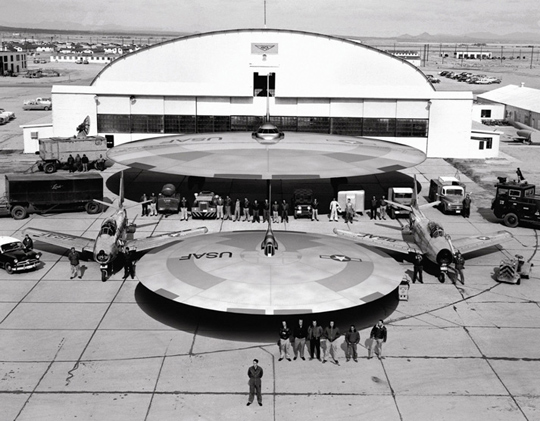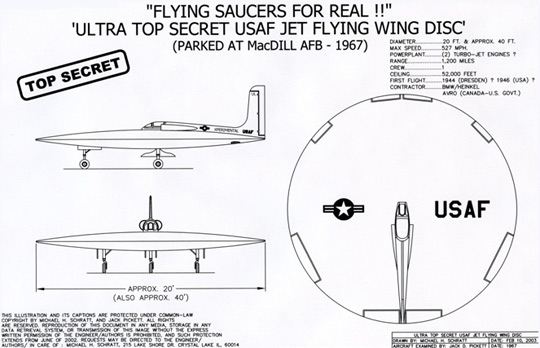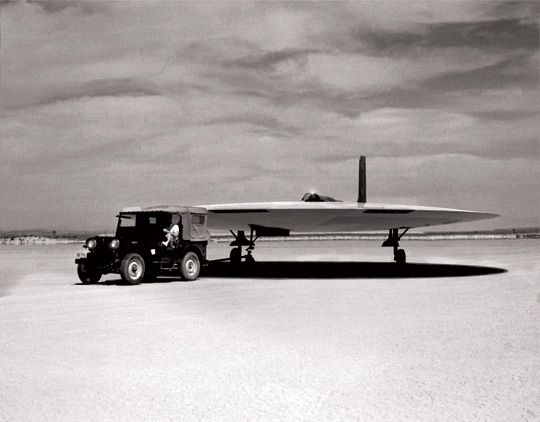Flying Saucers for real!
What you are about to read is still classified “TOP SECRET” by the United States Air Force.
(The secret truth behind U.S. built flying wing disc aircraft)
By Jack D. Pickett and Michael H. Schratt
Computer generated Illustrations by Gino Marcomini


NOTE: The pictures used in this article are computer generated forensic composite illustrations. These illustrations were specifically created to give the general public a technically accurate representation of what these historically significant aircraft looked like. Since the actual aircraft and official USAF photos are still classified, this article and the associated illustrations represent the most accurate historical account now in the public domain.
What you are about to read is still classified “TOP SECRET” by the United States Air Force. Now, after more than 60 years, the true story of the United State’s involvement into the design and construction of “Flying Saucers” can now finally come to light. This is not your run-of-the-mill “light in the sky” saucer story. In this case, the dates, names, and locations of very specific personnel and hardware can now be identified, which point to a very “terrestrial” explanation for many of the “UFO” sightings beginning since 1947. Please note: The images used in this article are computer generated forensic composite illustrations based on the actual testimony, drawings, letters, and detailed descriptions of Jack Pickett and Warren Botz. The illustrations were designed to give the general public the most accurate depictions ever created of these most unusual historical special purpose aircraft. A very strict scientific approach was used in the creation of these images. The process was identical to that of the federal government when they are trying to create a composite forensic sketch of a particular suspect.
THE REAL STORY: The case for U.S. built flying wing disc aircraft (aka flying saucers) begins with an unprecedented true account by Mr. Jack D. Pickett (retired WWII naval combat veteran and publisher). During the 1960’s, and on into 1972, Jack Pickett and his business associate Harold Baker published for the Air Force certain house-organ magazines (club-calendar-events) for NCO and Officer’s Club facilities for several military bases in Florida. It was September of 1967 when the Adjutant General’s Office at MacDill AFB (Tampa Florida) proposed a front cover, and two-and-a-half page article within. The subject was Vintage, Historical or Experimental aircraft.

THEY DO EXIST: Jack and Harold learned that some experimental jet aircraft were being stored at the base salvage/scrap-yard. These particular aircraft had already been decommissioned/declassified, and were parked directly outside, and NOT in a hangar. In September of 1967, both Jack and Harold drove together to where these aircraft were being parked. Upon arriving at the chain link fence, which surrounded the perimeter of the base near the scrap-yard, Jack first saw the most awe-inspiring aircraft ever built. Jack’s initial thought was: “My gosh! Those are Flying Saucers! Those things really do exist!.” There, parked outside on a taxi-way near the base scrap-yard, were four flying wing discs, measuring 20, 40, 70 and 116 feet in diameter. Jack recalled that the chain link fence was only 50 feet from were the discs were parked. Because they were the last remaining of their model, the Master Sergeant of the Non-Commissioned Officer’s Club telephoned the Adjutant General’s Office for permission for Polaroid photographs to be taken, even though all of the tires were completely flat down to their wheel rims. The Master Sergeant stated to Jack that he was not sure what these aircraft were for, but thought they might be some sort of “test” aircraft. The General’s Office suggested that Jack use higher quality official Air Force photographs available at the Adjutant General’s library at MacDill. Apparently, the Air Force wanted to make a good impression, and did not want to release photos of these aircraft with flat tires and at least one sagging landing gear strut (see sub-heading Large Disc). Jack was also informed that it would not take long to bring these aircraft back up to “flying status”. Jack Pickett was issued for his article, the highest security clearance ever given to any civilian publisher due to his prior work with SAC/TAC/Navy/Army bases. Under armed military guard, Jack was personally shown literally hundreds of official U.S.A.F. photographs of these aircraft in formation flight, on the tarmac, and was shown portions of motion picture footage of these aircraft in flight. Jack was allowed to select those photographs best suited for the up-coming NCO Club newsletter article, and obtain additional detailed information concerning the discs. It’s important to note, that these four aircraft are NOT to be confused with the well known Avro VZ-9 Avrocar, Chance Vought V-173 “Flying Pancake”, Project Silverbug, or the Chance Vought XF5U-1.

DESCRIPTIONS OF THE DISCS: Authors special note: It’s important to note that when describing the outward appearance of these aircraft, all aviation researchers and historians should 100% discard all of their pre-conceived ideas of what an aircraft should look like. When Jack first saw the official USAF photos of these aircraft, he was amazed, and immediately asked questions regarding how large, and how many of these aircraft were built. Jack also inquired about the flight performance (altitude and cruise speed) for these aircraft. Some of the in-flight photos clearly showed the discs being escorted by an F-84F Thunderstreak (swept-wing) interceptor aircraft. A few of the in-flight photos also appeared to show F-80 Shooting Star, F-86 Saber and F-100 Super Saber jet aircraft. Some of the photos that Jack was shown, included 50 aircraft flying in formation. Author’s special note: The specific USAF squadron that flew chase for these discs carried the unique designation “FLITAFF” (Fighter Long-range Tactical Air-command Future Forces). This support group (SG) was at one time stationed at Carswell AFB (Fort Worth Texas), than later transferred to James Connolly AFB (Waco Texas). Indeed, “FLITAFF” was actually painted on a hangar at James Connolly AFB. Looking head on, they appeared as the classic so-called “Flying Saucer” shape, very similar to two saucers stacked one over the other. The pilot/crew compartment appearing as a bubble shaped contour located directly in the middle of the top of the disc. There was nothing forward of the pilotís compartment other than the sloping surface. That compartment featured a ìspinal fairingî that ran from the canopy, and tapered back towards the trailing edge of the disc, narrowing down to a very high vertical tail. The small 20′ diameter craft had a crew of one, with an air-intake on both sides of the pilotís compartment, and two exhaust ports at the aft lower portion of the disc. The air-intakes could best be described as looking very similar to that of a Harrier or Douglas A-7 Skyhawk. This aircraft also employed control surfaces along the circumference of the disc. Jack also recalled that all four aircraft had a small black ìnon-slipî walk-way that ran along the length of the fuselage, leading up to the pilot/crew compartment. According to Jack, the smaller disc seemed to incorporate a sort of magnifying/enlarging optical sight, which was directly embedded into the 1-1/2 to 2″ thick canopy windows. This may have been used as a flat armored glass windscreen. The standard Air Force insignia, and the designation “XPERIMENTAL” followed by “USAF”, was visibly printed starting immediately behind the windows of the compartment on towards the tail. On the upper surface of the vertical stabilizer, there was the identification “U.L.” which stood for “Unlimited Altitude”. Jack was informed that the discs had considerable various uses. The O.I.C. permitted Jack to actually kick the tires of the smaller 40′ craft, while the O.I.C. stood nearby and snapped a photo in the process. The 40′ disc featured a hinged canopy that flipped up to allow entry for the pilot. All four discs were polished aluminum silver in color, with the aircraft skin seams and rivets clearly visible. Jack recalled that the aircraft “skin” was in good condition, and did not show signs of excessive oxidized wear. He was also permitted to run his hand along the edge of the smaller discs. Amazingly, each aircraft was so exceedingly streamlined that it appeared as though each craft were made out of one piece. The discs themselves, regardless of size, all had tricycle landing gear. The size of the aircraft, determined how many wheels on each. The 20′ and 40′ discs incorporated a single wheel on all three landing gear struts, while the 70′ diameter version used dual wheels all around. When Jack was permitted to walk around these discs, it was clear to him that both the 20′ and 40′ diameter craft were of single pilot design, while the 70′ craft was a two seat tandem model. Jack also recalled that on the very forward leading edge of all of the discs, there appeared to be a “retractable slotted window”, which may have been used to improve pilot visibility during approach to landing. For whatever reason, the top entry hatch of the small 20′ diameter disc was left open, leaving it exposed to the elements. According to the O.I.C. (Officer in charge) of MacDill, all four aircraft had been flown in, and then immediately parked outside at the scrap-yard. The O.I.C. also informed Jack that not one person had ever been allowed to enter any of the discs since they arrived.
THE LARGE DISC: Measuring 116 feet in diameter (comparable to the wingspan of a B-47 Stratojet), and standing 12′ off of the ground, (much higher near the edge) the largest of the four discs must have been a sight to behold. The O.I.C. permitted Jack to walk under and around this aircraft, but was soon told to come out from under it due to possible safety issues. Jack specifically noted that the port main landing gear of the large craft was partially collapsed, causing the aircraft to lean to the left. Each main landing gear consisted of 6 wheels, measuring 5′ in diameter. Incredibly, the nose gear had 32 wheels which measured 2-1/2 to 3 feet in diameter. Indeed, Jack recalled that “the front landing gear had more wheels than I had ever seen on any aircraft before.” The fact that this large aircraft utilized multiple nose wheels on the nose gear indicates that it was only intended to be operated from hard surface runways. Although all of the tires on this craft were flat, Jack noted that they did not appear exceptionally worn. A door was located on the port side of the craft, for access to the crew compartment. Immediately behind the door, there were three oblong rectangular shaped windows that ran along both sides of the fuselage. These may have been stations for the flight engineer, navigator, and weapon systems operator. The extreme forward section of the crew compartment looked like the nose of a Curtiss C-46 transport aircraft. The large craft employed two air-intakes on both sides of the crew compartment, and four exhaust ports at the aft bottom end of the craft. The air intakes blended beautifully into the sides of the fuselage and upper portion of the disc. It was clear that the crew compartment had room for a pilot and co-pilot who sat side-by side. The main cabin/fuselage appeared very similar to that of a Douglas DC-6 passenger airliner, with enough room for a central isle, and two seats on either side. The upper portion of the vertical stabilizer had the designation “U.S.” which stood for “Upper Stratosphere”.
Jack specifically recalled that the unusually high vertical stabilizer was “higher than shopping mall parking lot lights.” It was evident that the main landing gear retracted inside the main body of the disc, with the gear moving up and away from the centerline of the aircraft. The nose gear retracted to the rear and up inside the bottom of the disc. Flight control surfaces were located along the circumference of the disc, similar to the 20′ model. Jack remembers seeing what may have been bomb bay doors located on the bottom surface of the disc. These may have been used for the release of 10′ diameter in-flight radio controlled flying wing disc bomb drones. Indeed, Jack remembers seeing flying wing disc drones in various stages of disrepair at the scrap-yard, near the four discs. These bombs were capable of being delivered with “pin-point” accuracy decades before Lockheed F-117 Stealth Fighters dropped “smart bombs” on Iraq during the Gulf War. This indicates that the primary mission for this aircraft may have been that of a long range reconnaissance bomber. All of the evidence indicates that the special mission of the smaller manned discs, was that of a high speed, high altitude espionage platform. The O.I.C. also informed Jack that this aircraft had “nuclear capabilities”. Jack was told that this aircraft regularly over-flew Russia after WWII, but was told: “you canít print that.” It was obvious to Jack that this large craft would totally do away for the need of long range bombers, escort fighter aircraft, refueling aircraft, support crews, and air bases. What would be the point of manufacturing additional support aircraft, when you had an aircraft that could “do it all?” Of course this would not sit well with the military industrial complex which stands to make billions of dollars manufacturing ordinary run-of-mill support aircraft. This specific point was brought home during President Dwight D. Eisenhowerís farewell address to the nation delivered on January 17th, 1961. President Eisenhower stated that “In the councils of government, we must guard against the acquisition of unwarranted influence, whether sought or unsought, by the military-industrial complex. The potential for the disastrous rise of misplaced power exists and will persist.” This he knew from personal experience, and was well aware that when the military and defense contractors ìslept togetherî bad things happen.
AIRCRAFT PERFORMANCE: When Jack asked the O.I.C. if these were the Flying Saucers everybody was reporting, he was given an affirmative reply. Itís clear that what was being reported in the news media as “Flying Saucers” was one of the smaller craft, specifically the 40′ diameter model. The overall logistics and tremendous costs involved in manufacturing the giant 116′ model may have prevented it from being produced in great quantity. Jack Pickett was never briefed on the exact propulsion system utilized by the four craft, or who specifically built these aircraft. Jack also inquired why they had been discontinued, and was told that it had to do with stability/maneuverability problems, and that the U.S.A.F. now had “better ones.” Author’s special note: Although the following important point seems difficult if not impossible to believe, it has been included into this article for historical purposes. In regards to the specific performance of these aircraft, Jack was told directly by the O.I.C. that “we could fly so fast as to attain sufficient altitude to be classified as achieving space flight.” This is consistent with the official USAF classification that space flight begins at an altitude of 50 miles, or approximately 265,000 feet. For Jackís article, the O.I.C. told him that he could state that these aircraft could “exceed mach 1”, a very conservative under-statement to say the least. This leaves the very real possibility that these jet disc aircraft employed a secondary propulsion system which might have been associated with the USAF NEPA (Nuclear Energy for Propulsion of Aircraft) program (1946-1961). Jack inquired how these aircraft could avoid burning up while descending from such high altitudes. He was told that during re-entry these aircraft “skip” across the upper portion of the atmosphere, thereby slowing down and dissipating the extreme heat (similar to a flat rock when thrown across a body of water). Jack was also told by the O.I.C. that “had we had different power source engines, we could have gone into orbit” (orbital flight requires 17,500 mph, 25,000 to reach the moon and planets). Jack was also told that these aircraft were more secret than the “Manhattan Project”. Author’s special note: Those that are skeptical of the reality of man-made flying saucers would do well to review the sighting made by former Mercury Seven astronaut and test pilot Gordon Cooper. During 1951 in Europe, Gordon Cooper and his squadron-mates attempted to intercept a group of silver saucer shaped craft. Flying their F-86 Saber jets at 45,000 feet, they were unable to catch the discs. Gordon Cooper reported that the discs were flying much higher, and traveling far to fast to be intercepted by his F-86. Colonel Cooper recalled that these discs were seen in flying formations of four and sixteen.
THE PROPOSED ARTICLE: The four disc shaped experimental aircraft were never featured in the October 1967 issue of “NCO Club News”. Coincidentally, while putting that article together, there was a UFO/Flying Saucer sighting which occurred directly over downtown Miami. That particular aircraft Jack was told, originated from Avon Park Air Force Range located 100 miles Southeast of MacDill AFB. Avon Park consisted of runways far too short for the operation of conventional high speed, horizontal take-off aircraft. Only “harrier type” or VTOL aircraft would be ideally suited for operations at this facility. Jack learned that this new prototype developed a propulsion system malfunction, which caused it to drop down to “tree-top level”. The crew was desperately trying to keep the craft airborne long enough to clear Miami so that they could crash land offshore into the Atlantic Ocean. Eventually, the flight crew regained control of the aircraft, which quickly turned straight up, and departed the Miami area at a tremendous speed. Itís entirely possible that a more advanced prototype VTOL variant (possibly Project Silverbug) of the original four discs stored at MacDill was responsible for the over-fly of Miami. Immediately after the Miami over-fly, Jack bought a copy of the Tampa Tribune morning edition (which carried an article on the sighting), and brought this sighting, which took place approximately on September 20th of 1967 to the attention of the O.I.C. at MacDill, who personally felt that he should make a request to higher Air Force authority for the clearance needed for publication at that time (this sighting was also reported in the Miami Herald). The O.I.C. specifically told Jack “Yes, I know about that aircraft.” This was now the making of the biggest and most decisive “catch 22” that the U.S.A.F. ever found itself in. On one hand, the Air Force was standing on the door-step ready to officially release information pertaining to the four discs parked at the scrap-yard which had already been decommissioned/declassified. On the other hand, Jack was told: “the U.S. Air Force would never admit that aircraft ever existed, never” (referring to the aircraft that took off from Avon Park, and was responsible for the Miami sighting). Jack was specifically told that it would be in the “better interest of the Air Force” to delay publication of his article. Jack was seated across the desk from the O.I.C. during their meeting. The O.I.C. also possessed the official U.S. Air Force stamp which was ready to go on the back of each of the photos Jack had picked out earlier. Due to the fact that the Air Force had changed their mind, the O.I.C. began taking back the photos. At this exact point, the official declassification of these incredible discs was officially terminated. Jack was later told that “Nobody will ever see these aircraft again, until they re-appear as U.S. space craft” (possible replacement for current space shuttle). Author’s special note: During the time that Jack was examining the discs at the scrap-yard, he noticed a hangar nearby. When Jack asked the O.I.C. what was in that hangar, he replied “I’m not going to tell you what’s in that hangar.” Speculating about the contents of this restricted hangar would be outside the scope of this article. However, it now appears that for what-ever reason, MacDill AFB was chosen as a sort of “clearing house” or storage facility for Ultra Top Secret Experimental aircraft.
The time has come for the U.S.A.F. to fully declassify and release into public domain, the technical details, photos, and motion picture/newsreel footage pertaining to these specific aircraft. Any potential threat to National Security has now been far out-weighed by the economic and environmental benefits derived from the propulsion systems employed on these aircraft. Indeed, we can no longer as a civilization, go on using obsolete solid and liquid rockets to achieve space flight. There is a “better way” to access space. It’s now time for the military industrial complex, and the highest level of U.S. leadership to finally admit that “the game is up”, and that the American people, and the world, demand a full disclosure regarding highly classified aerospace vehicles and propulsion systems. Only then, can we all take our rightful place among the stars, and fully reach our potential to discover new worlds, just over the horizon.
